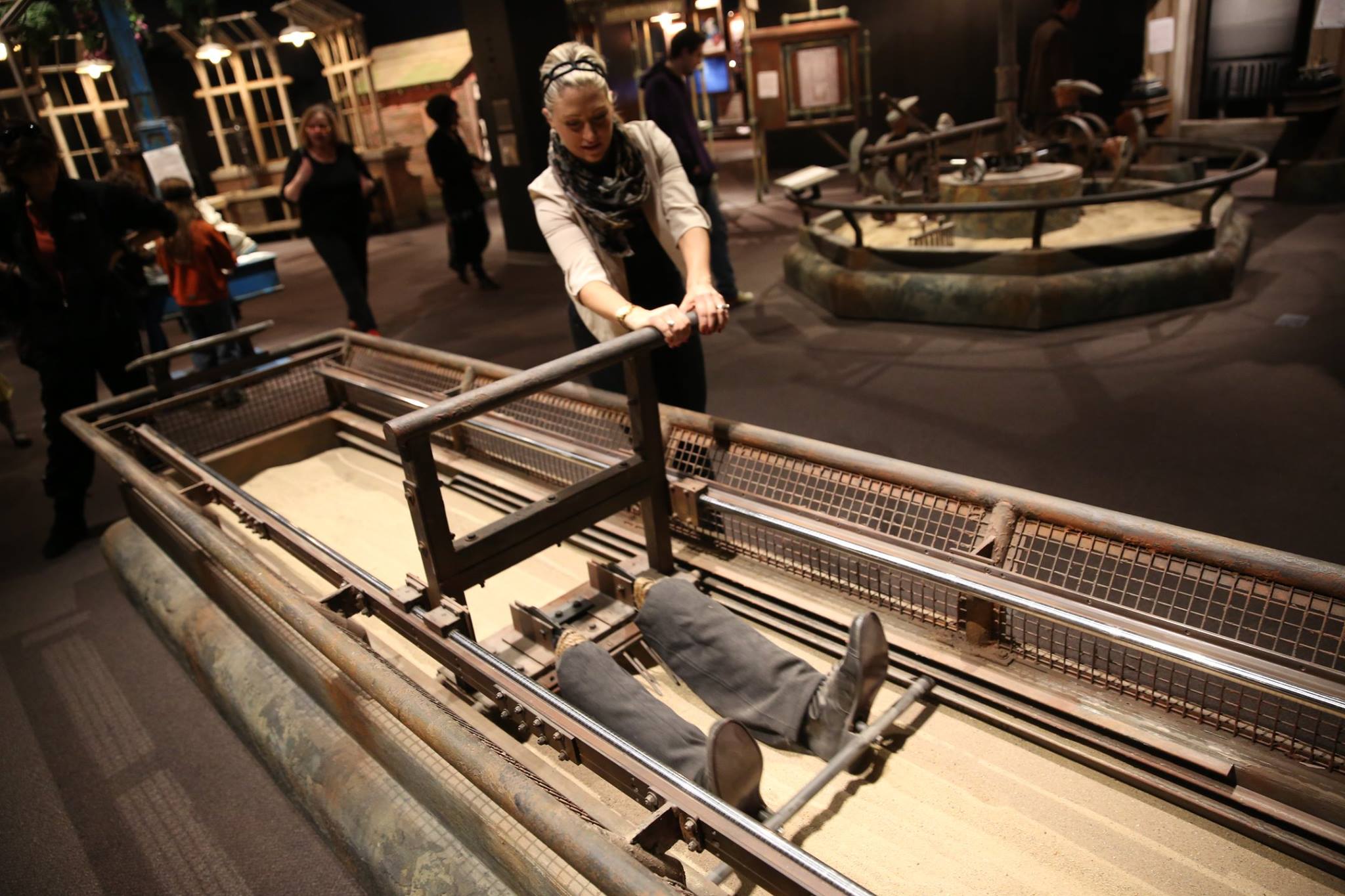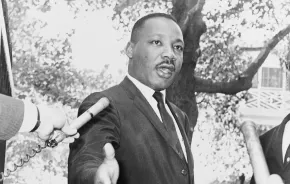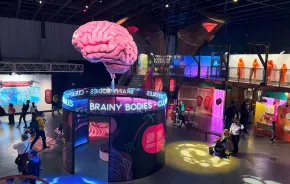
Sherlock Holmes needs your help. NOW. It seems that while you and the kids were perusing exhibits on the emergence of forensic science and innovative technologies in the Victorian era, a crime was committed.
There is a crime scene and a suspect. There is evidence: blood splatter, marks in the sand where a body may have been dragged, a broken statue. There is an incoherent suspect who is a journalist and botanist. There is a seed pod. Two people have disappeared.
In a recording played from a large phonograph, Holmes rapidly lays out the facts, as well as advice on how to go about solving the case. Most important: "Trust the evidence, not the theories."
Just so you know, he's also a bit doubtful of your crew's abilities. "On the whole you are not a particularly promising group," he muses, but dispatches you nonetheless with these famous words: "Hurry along now. The game is afoot."
Luckily, as a visitor to Pacific Science Center's new, wonderfully immersive The International Exhibition of Sherlock Holmes, you have been well-primed for solving a mystery in the Holmesian way of observation and the scientific method. You just wandered through a gallery that explained — through richly detailed, beautifully designed exhibits — how Sir Arthur Conan Doyle, trained as a doctor, created Holmes and his world in part to show how crimes could be solved through forensic science (a new idea at the time).
In another gallery, which recreates the streets and storefronts of Victorian London in movie-set fashion, you learned how the technological innovations of the time, from the telegraph to microscopy to photography, as well the rise of modern policing, made a fictional detective like Holmes possible.
So by the time you entered the third gallery — which opens with a set of Holmes' cluttered residence on Baker Street — you are ready for your mission.

The road to 221B Baker Street
The vast majority of visitors to the Pacific Science Center exhibit, which opens Saturday, Oct. 15, and runs through Jan. 8, 2017, are ready for another reason. Unless you grew up under a rock, you've been touched by Conan Doyle's series in multiple ways, even if you've never read a Holmes mystery.
"The power of the characters in the stories hasn't wavered since they were written," says Geoffrey Curley, whose firm was part of a team who developed and designed the exhibit (other partners included the Conan Doyle Estate and the Oregon Museum of Science and Industry (OMSI), as well as experts such as Conan Doyle biographer E.J. Wagner).
"It's become a part of our life," he says. "[Holmes] is almost a synonym for detective." Conan Doyle, he notes, changed the way mystery stories were told to focus on evidence and observation, and popularized the role of the scientific method in police work. "It pushed the public to want to have police departments use forensic science," he says.
And its pop culture influence, of course, is legendary. One hundred thirty years after Conan Doyle published his first Holmes book, A Study in Scarlet, in 1886, Sherlock and Watson continue to inspire TV series, movies, adaptations, kids' picture books and more.

The International Exhibition of Sherlock Holmes was inspired in part because of a newly burgeoning interest in Conan Doyle's works and its era, starting with Robert Downey, Jr.'s film, released in 2009. "It opened up a new generation of Sherlock Holmes fans,” says Curley. (The final gallery in the PSC explores the cultural influence of Sherlock Holmes, with movie props, videos, editions and more.)
Not quite elementary
Back to the exhibit itself. From the moment you step into the first gallery, you are steeped in a meticulously recreated Victorian world, from the display of the period artifacts (manual typewriter font, 19th-century tacks) to the set of Holmes' sitting room (scattered with 19th-century scientific equipment, journals and Victorian newspapers) to the Baker Street train station. Adding to the atmosphere is 19th-century London background noise: whistling trains and spooky parlor music.

The exhibit is also highly interactive — a great boon for families. At the beginning, visitors pick up their own personal detective book, which is part scavenger hunt and part mystery-solving tool. Younger kids will enjoy looking for activity stations where they can do things like tap out telegraph messages and look through miscroscopes, collecting stamps for each activity. After the facts of the mystery are handed out, older kids and grown-ups can use the booklet and corresponding stations to collect and analyze evidence to solve the crime. (Documents from Holmes provide helpful tips.)

Examples: Collect a sample of how the blood splattered and then experiment with similar blood patterns at a slaughterhouse (yes, you get to spray fake blood). Put pieces of a statue back together to see if a bullet shattered it. In one of the most engaging activities visitors drag a pair of prosthetic legs to figure out whether a body was dragged in the sand. Slowly, evidence points to a conclusion. Is it the right one? Eventually, all will be revealed.

So now for the caveats: This is not a rush job. Going through the steps to solve the mystery requires patience, focus and a dedication to following instructions. Kids younger than 8 or 9 will enjoy aspects of it, but might lose focus (as might many grown-ups!). As Curley notes, the case is a perfect activity for groups, and collaboration will naturally happen as people journey through the exhibit.
Not only is it complex, but each gallery, from the initial displays about Conan Doyle and his time to Baker Street and beyond, is layered in artifacts, sets and texts. If you have the time to immerse yourself, the worlds of Victorian England, Conan Doyle, Scotland Yard and modern forensic science are yours for the discovering.
Is it right for my junior detective?
As noted, kids ages 8 or older, who already understand the basics of the mystery genre, will be more likely to enjoy all aspects of the exhibit. (Warning: They might pick up the clues faster than you.) Pacific Science Center will have a junior detective guide on hand for younger kids.
Content caveats: The subject matter, of course, deals will murder and crime. In the first gallery, there are some artifacts — a skin sample with stab wounds, skulls showing passage of bullets — that aren't gory but might be disturbing to sensitive or younger kids. (But you could easily skip over the first gallery.) Guns are on display and some of the evidence gathering relates to blood, bullets and, well, murder.
But as Curley says, "The atmosphere is very noir and moody but you don't see anything gory. I've seen a 4-year-old [playing on] on the blood gun machines and having a great time."
Final tip: If this is the kind of exhibit that thrills you, then you might want to go without your kids (date day alert!).
 If you go ...
If you go ...
When: Oct. 15, 2016–Jan. 18, 2017
Where: Pacific Science Center
Prices: There is an additional fee beyond regular PSC admission ($7 members, $9, non-members). Tickets are available to purchase at Pacific Science Center’s box office. You may also reserve your ideal date in advance by purchasing online or by phone at 1-800-664-8775. Group tickets can be purchased by phone at 206-443-3611.
Exhibit entry: Entrance will occur on a first-come, first-served basis beginning at 10 a.m. daily.
Tips:
- Much of the exhibit documentation is in Spanish as well as English.
- Make sure you allow enough time (at least 90 minutes) to experience the exhibit and solve the crime
- The mystery galleries do have mutiple stations for each clue, but will get crowded on busy days. Try to go on a non-weekend day, or later in the exhibit's run.
Other things to see at Seattle Center: See our ultimate guide.
Resources: Check out Seattle Public Library's terrific list of books about Sherlock Holmes
City-wide Sherlock scavenger hunt: Starting Oct. 13, PSC is launching “The Case of the Missing Tickets” scavenger hunt. Follow PSC on on Twitter or Facebook to find a London Prize Package in a hollowed out book that includes roundtrip tickets to London; tickets to The London Museum and more awesomeness. Ten clues will be distributed from October 13–23. One winner, who is the first to discover the tickets’ location, will win the prize package.











